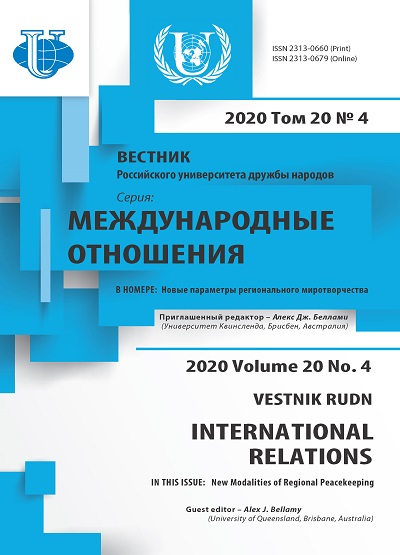Terrorist Islamist Groups on the Sinai Peninsula
- Authors: Krylov A.V.1
-
Affiliations:
- MGIMO University
- Issue: Vol 20, No 4 (2020): New Modalities of Regional Peacekeeping
- Pages: 763-780
- Section: PEACE AND SECURITY
- URL: https://journals.rudn.ru/international-relations/article/view/25281
- DOI: https://doi.org/10.22363/2313-0660-2020-20-4-763-780
Cite item
Full Text
Abstract
The article examines the illegal activities of terrorist Islamist groups in the Sinai Peninsula. Within the framework of this study, the main attention is focused on the analysis of those links that make up the modern structure of local takfiri jihadist organizations that oppose the secular government of Egypt and demand the establishment of an Islamic order in the country based on Sharia law. The author reveals the reasons that turned one of the most famous resort areas in the world into a hotbed of terrorism and Islamist extremism. After the destruction of the quasi-state structures of the so-called “Islamic State” in Syria and Lebanon, a significant part of its militants moved to hard-to-reach areas of the Sinai Peninsula. An extensive network of well-armed bandit formations was created here, which carried out hundreds of terrorist acts. On October 31, 2015, a Russian Airbus A320 belonging to the Kogalymavia campaign was blown up over the central part of the Sinai Peninsula. As a result of this plane 224 people were killed, and the Russian government was forced to interrupt air traffic with Egypt, as a result of which the Egyptian budget suffered multibillion-dollar losses. A significant part of the article is devoted to an analysis of the response measures taken by the current Egyptian government to eliminate hotbeds of terrorist threats in the Sinai and establish an effective security regime on the peninsula. At the same time, the author reveals all the shortcomings admitted by the authorities of the Arab Republic of Egypt during counter-terrorism operations. The article presents consolidated recommendations for the Russian state foreign affairs agencies that currently determine the level of security in the areas where Egyptian attractions and resorts are located and, therefore, the possibility of restoring in full the cooperation of the Russian Federation with Egypt in the tourism sector. The article may arouse the interest of all those who associate themselves with the Middle East scientific community, as well as those who are professionally involved in the problems of terrorism and the fight against terrorist threats and challenges in the region.
About the authors
Alexander Vladimirovich Krylov
MGIMO University
Author for correspondence.
Email: avkrylov2004@mail.ru
PhD, Dr. of Sc. (History), Professor, the Department of Oriental Studies, Leading Researcher, Center for Middle Eastern Studies, Institute of International Studies
Moscow, Russian FederationReferences
- Aziz, S.F. (2017). De-Securitizing Counterrorism in the Sinai Peninsula. Brookings Doha Center Publications, 1—17.
- Bauer, K. (Eds.). (2016). Beyond Syria and Iraq: Examining Islamic State Provinces. Washington: The Washington Institute for Near East Policy.
- Colin, P.C. (Eds.). (2018). Terrorism: The Essential Reference Guide. Santa Barbara, USA: ABC-CLIO.
- Dentice, G. (2018). The Geopolitics of Violent Extremism: The Case of Sinai. Barcelona: European Institute of the Mediterranean Consortium (EuroMesCo).
- Dyer, Е. & Kessler, О. (2014). Terror in the Sinai. London: The Henry Jackson Society.
- Egypt Security Watch (2017). Five Years of Egypt’s War on Terror. The Tahrir Institute for Middle East Policy (TIMEP). P. 1—62. URL: https://timep.org/wp-content/uploads/2018/07/TIMEP-ESW-5yrReport-7.27.18.pdf (accessed: 12.01.2020).
- Gaub, F. (2015). Counterinsurgency: Not an Arab Specialty. European Union Institute for Security Studies (EUISS) Brief Issue, 20, 1—4.
- Ghanem, H. (2014). Egypt’s Difficult Transition: Why the International Community Must Stay Economically Engaged. Brookings Institution Global Working Papers Series, 66, 1—47.
- Gold, Z. (2014a). Salafi Jihadist Violence in Egypt’s North Sinai: From Local Insurgency to Islamic State Province. The International Centre for Counter-Terrorism — The Hague (ICCT) Research Paper. P. 1—44.
- Gold, Z. (2014b). Security in the Sinai: Present and Future. The International Centre for Counter-Terrorism — The Hague (ICCT) Research Paper. P. 1—29.
- Harel, M. & Nir, D. (1976). Eretz Israel. Geographic Outline. Jerusalem: Biblioteka Aliya publ. (In Russian).
- Hilary, G. (2013). Nature = Life: Environmental Identity as Resistance in South Sinai. Nomadic Peoples, 17 (2), 40—67.
- Idris, I. (2017). Sinai Conflict Analysis. K4D Helpdesk Report. P. 1—14.
- Jones, S.G. (2014). A Persistent Threat: The Evolution of al Qa’ida and Other Salafi Jihadists. RAND Corporation Research Report Series. P. 1—92.
- Jones, S.G., Dobbins, J., Byman, D., Chivvis, C.S., Connable, B. et al. (2012). Rolling Back the Islamic State. RAND Corporation Report Series. P. 1—29.
- Krylov, A.V. & Morozov, V.M. (2018). The Ideology of Hamas: From Radical Islamism to Rational Practicality? Journal “Polis”. “Political Studies”, 4, 84—99. (In Russian). doi: 10.17976/jpps/2018.04.07
- McCarthy, А. (2012). Spring Fever: The Illusion of Islamic Democracy. N.Y.: Encounter Books.
- Oskarsson, K. (2017). Egypt’s Security and Economic Nexus. OPEN Publications, 1 (10), 1—21.
- Plebani, А. (Eds.). (2014). New (and Old) Patterns of Jihadism: Al-Qa’ida, the Islamic State and Beyond. Milan: Istituto per gli Studi di Politica Internazionale.
- Roberts, А., Michael, J.W. & McCarthy, R. (Eds.). (2016). Civil Resistance in the Arab Spring: Triumphs and Disasters. New York: Oxford University Press.
- Roy, S. (2013). Hamas and Civil Society in Gaza: Engaging the Islamist Social Sector. Princeton: Princeton University Press.
- Siboni, G. & Ben-Barak, R. (2013). The Sinai Peninsula Threat Development and Response Concept. Center for Middle East Policy Analysis Papers, 66, 1—17.
- Vannoni, M.G. (1998). Sensors in the Sinai: A Precedent for Regional Cooperative Monitoring. SAND Report. P. 1—81.
- Watanabe, L. (2015). Sinai Peninsula — from Buffer Zone to Battlefield. CSS Analyses in Security Policy, 168, 1—4.











